#survey data entry
Explore tagged Tumblr posts
Text
2 notes
·
View notes
Text
30 Ways to Make Extra Money as a Student
In today’s increasingly competitive academic landscape, many students are seeking opportunities to earn additional income. The need for financial stability has driven numerous individuals to explore innovative ways to make extra money while pursuing their studies. This article provides a comprehensive list of 30 practical methods that students can employ to supplement their income. These…

View On WordPress
#bookkeeping#car washing#data entry#delivery driver#event planning#extra money#fitness coaching#freelance writing#graphic design#house cleaning#language tutoring#lawn care#music lessons#online marketing#online surveys#part-time jobs#pet sitting#photography#resume writing#SEO optimization#social media management#student income#student jobs#tutoring#virtual assistant#virtual tutoring#ways to make money#website design
3 notes
·
View notes
Text
Navigating Market Realities: Understanding Market Research Methods, Types & Examples
Explore diverse market research methods, types, and real-world examples in our insightful blog. Elevate your business strategy with data-driven insights.
#Market research#Research methods#Types of market research#Examples of market research#Market analysis#Consumer behavior#Data collection#Quantitative research#Qualitative research#Surveys#Focus groups#Interviews#Sampling techniques#Market segmentation#Competitive analysis#SWOT analysis#Market trends#Product testing#Brand perception#Market entry strategy#Market sizing#Primary research#Secondary research#Data analysis#Market research tools#Customer feedback#Online surveys#Social media analytics#Mystery shopping#Observational research
1 note
·
View note
Text

4 Important Steps in Survey Data Processing
Learn how survey data entry and processing services can help organizations shape their long-term objectives effectively. Explore the crucial steps involved, from survey designing and data entry to quality assurance and reporting. Understand the importance of high-quality survey data in making informed business decisions. To read more visit https://www.suntecindia.com/blog/4-important-steps-in-survey-data-processing/
#Data Processing#Survey Data Processing#Important Steps in Survey Data Processing#Data Entry#Data Capture
0 notes
Text
"For over a decade, the Yosemite toad has been recognized as a federally threatened species, after experiencing a 50% population decline during the Rim Fire of 2013.
The wildfire, which encompassed a mass of land near Yosemite National Park, made the amphibian species especially vulnerable in its home habitat.
Native to the Sierra Nevada, the toads play a key role in the area’s ecosystem — and conservationists stepped in to secure their future.
In 2017, the San Francisco Zoo’s conservation team began working with the National Park Service, Yosemite Conservancy, U.S. Fish & Wildlife Service, California Department of Fish & Wildlife, and the U.S. Geological Survey.
The goal of all of these stakeholders? To raise their own Yosemite toads, re-establishing a self-sustaining population in the wild.

“Over the past several years, SF Zoo’s conservation team has been busily raising hundreds of these small but significant amphibians from tadpole stage, a species found only in the Sierra Nevada, for the purpose of reintroducing them to an area of Yosemite National Park where it was last seen 11 years ago,” the zoo shared on social media.
By 2022, a group of toads were deemed ready for release — and at the end of June of this year [2024], 118 toads were flown via helicopter back to their habitat.
“It’s the first time anyone has ever raised this species in captivity and released them to the wild,” Rochelle Stiles, field conservation manager at the San Francisco Zoo, told SFGATE. “It’s just incredible. It makes what we do at the zoo every day worthwhile.”
Over the past two years, these toads were fed a diet of crickets and vitamin supplements and were examined individually to ensure they were ready for wildlife release.
Zoo team members inserted a microchip into each toad to identify and monitor its health. In addition, 30 of the toads were equipped with radio transmitters, allowing their movements to be tracked using a radio receiver and antenna.
The project doesn’t end with this single wildlife release; it’s slated to take place over the next five years, as conservationists continue to collect data about the toads’ breeding conditions and survivability in an ever-changing climate. They will also continue to raise future toad groups at the zoo’s wellness and conservation center...
While the future of the Yosemite toad is still up in the air — and the uncertainty of climate change makes this a particularly audacious leap of faith — the reintroduction of these amphibians could have positive ripple effects for all of Yosemite.
Their re-entry could restore the population balance of invertebrates and small vertebrates that the toads consume, as well as balance the food web, serving as prey for snakes, birds, and other local predators.
“Zoo-reared toads can restore historic populations,” Nancy Chan, director of communications at the San Francisco Zoo, told SFGATE.
Stiles continued: “This is our backyard, our home, and we want to bring native species back to where they belong.”
-via GoodGoodGood, July 11, 2024
#yosemite#yosemite national park#california#united states#amphibian#frogs and toads#frogblr#frogposting#toadblr#toad#endangered species#wild animals#biodiversity#wildlife conservation#wildlife#good news#hope
1K notes
·
View notes
Text
Made to Order
Franco pulled up to the apartment building of his latest client. He parked his car along the street and sent his client a quick text letting him know he had arrived. Franco then pulled out a pair of earphones from the glove compartment, connected them to his phone’s jack port, and put them on. He then booted up a survey app. It greeted him with a light blue screen and a ‘Hello!’ in a British accent.
“Let’s see what kind of guy this dude paid good money to bang…” Franco muttered to himself as he pulled up the list of responses from the survey he sent to his clients. He scrolled to the latest data entry and skimmed it over. A grin formed on his face as he read it.
“Alright then! No time like the present, let’s get to work.”
He downloaded the data entry into his phone’s local storage and composed it into an audio file. Once it was ready, Franco pressed ‘play’ and leaned back in his seat as the makeshift music began to fill his ears. He took a deep breath and cleared his mind of any and all thoughts, allowing the music to submerge his mind and body with powerful subliminal messaging.
Gender: Male. Age: 24. Height: 6’4” ft. Weight: 170 lbs.
Franco groaned as a cold chill ran up his spine. As he grew taller and heavier, the muscles in his legs rapidly flexed and relaxed.
“Ohhh… Fuckk man…”
Franco couldn’t help but massage his aching body as he began to physically transform. He became hyper-aware of how his body felt and moved, which made touching his sensitive skin with his warm hands all the more pleasurable as it gradually changed. Franco moved the car seat back, as he needed the extra space to accommodate his sudden growth spurt. He gained several inches of height and about 30 pounds until he matched the size his client had requested.
Hair Color: Brown. Eye Color: Green. Facial Hair? Mustache only. Body Hair? Yes.
The next few details of Franco’s client’s request rang in his ear and reverberated throughout his body. He gripped the sides of his seat as he felt his body working overtime to pump out heavy quantities of hormones. He winced in pain as his dark brown eyes changed colors. They became lighter and lighter in hue until they were a brilliant shade of green that glimmered in the sunlight.
Franco’s hair was next to transform. The straight, black hair on his head grew lighter and curlier until he had wavy, brown hair. The skin on Franco’s upper lip tingled and itched as the hair follicles began rapidly growing in. Franco let out a heavy moan as his mustache hairs kept growing and growing until he had a thick mustache that hung over his lips. Once he had the right mustache, his underarm hair began growing, too. Franco only had a light dusting of pit hair, but thanks to his strange audio files, he could grow well past his natural limits. His armpit hair grew longer and thicker until he had a jungle of brown pit hair in his underarms. His pit hair had become so long that it even peeked out when Franco had his arms down!
Ethnicity: Mexican. Language: Spanish, or English w/ Accent.
Franco let out a sigh of relief as he heard the next three lines of the audio file. Thankfully, the next transformation would be more mental than physical, which gave Franco a chance to take a quick breather.
He relaxed against the headrest as the audio file echoed inside his mind. The more Franco heard his client’s preferences, the more his psyche changed to match his request. Suddenly, Franco was no longer a middle aged man from Midwest U.S.A. but a young Mexican man who had only recently immigrated into the country. His mind became filled with all sorts of new knowledge surrounding his Mexican heritage and culture, such as the Spanish language.
“Mmm… Que rico…” Franco purred sensually as his throat muscles broadened and his vocal cords thickened, granting him the heavy accent his client had requested. The audio file also gave him a deeper voice too. Although that detail was more for Franco’s personal enjoyment than anything else.
But despite his newfound knowledge, there was only one thing the newly transformed Franco desired: to fuck as many men as physically possible. There was nothing he loved more than seeing a man pressed down against a pillow as he railed them to the next Tuesday. Just the thought of a man’s bubble butt swallowing his dick was enough to make him start leaking.
Size: 7.5 inches. Breed: Dom top. Body odor: YES.
While Franco was busy relishing his new voice and fantasizing about his next bottom, the next line of the audio file played, triggering the final piece of the transformation. Franco threw his head back as the next wave of bodily sensations caught him off guard. He let out loud, guttural groans as his manhood grew obscenely erect until it filled in his underwear. Franco massaged his sensitive, throbbing member as it grew longer and fatter than what he originally had. Before he knew it, Franco’s new endowment ripped the fabric of his briefs. His dick sprang to life like it was just begging to be released and played with as soon as possible!
Franco wrapped his hand around his new dick and gave himself a few strokes just to test out his new tool. As he did so, a rank smell began to fill his car. It was sweaty, smelly, and addicting. That scent was none other than his natural body odor but kicked up to 100%. With the windows rolled down, Franco was becoming hot-boxed off his own tantalizing smell. Not that it really bothered him, as he was too busy admiring the glorious sight of his new, hung cock standing at full mast with a healthy bush of thick pubes to complete the look.


A tap on the window interrupted Franco’s moment of self-admiration. He glanced over and saw his client watching him with hungry eyes and a hand stuffed down his pants. Franco smirked, then rolled down his window.
“Hola papacito. ¿Te gusto?” Franco flexed his arms and winked at his client. The man nodded vigorously like a dog begging for a juicy steak. Then, he took a heavy whiff of Franco’s potent body odor and sighed, satisfied.
“I can’t wait any longer! C’mon, let’s get you inside!!”
Franco grinned. He loved the whiny sound of a man begging to get fucked. He tossed his phone and earphones to the side and followed his client up to his apartment, where he proceeded to show him the dom Mexican top he requested to fuck him hard and raw. Another man made to order, another man satisfied.
661 notes
·
View notes
Text
kroger shoppers and butch4butch: failures of categorization, failures of desire
(originally published in 2023’s yaoi zine 2: the analysis issue and I realized I never crossposted. you Should check out the full pdf. it slaps.)
I. Survey Fatigue
The year after graduating college, I spent about six months filling out online surveys. In between sending out job applications, I trawled r/beermoney and r/workonline for survey clearinghouse websites, where I could (ostensibly) earn money by giving various nebulous corporations a large amount of information about my preferences on everything from TV to deodorant.
Unfortunately for the me of 2016, survey clearinghouses are not actually a great way to make very much money. Most surveys with low barriers to entry don’t pay very well, unless you happen to stumble on a well-funded academic researcher. Even in a more naive era in which there was still an expectation that consumers should be paid for their data, the ecosystem of survey-based consumer demographics collection is deeply exploitative, with most surveys on public clearinghouses that aggregate many different companies together paying well below minimum wage for the amount of time they take to fill out. (We’re talking, like, $1 for 20 minutes.) Which makes sense, as their ideal candidate is middle-aged, upper middle-class or higher, owns a home and at least one car, has multiple kids, is considering upgrading every category of possession imaginable, and is taking this survey in her free time because she feels deeply passionate about shaping the products of the future. (Many surveys are aimed at women, because, you know. Women be shopping.)
What survey clearinghouses are, instead, is a fantastic way to spend a lot of time thinking about how others might categorize your identity. Marketing research focuses on particular demographic categories, and survey clearinghouse sites overwhelmingly use screeners to make sure that only people who fit that category take the survey. If you’re a marketer interested in the grocery habits of northeastern women with multiple kids, you don’t want some single guy in California’s data. But if you’re a single guy in California, or (just as an example) a nonbinary recent college grad in the south, trying to make some extra cash, and you know you won’t get paid for the time you spent taking the screener, it’s in your interest to try to figure out exactly what the marketers want from you, and adapt your profile accordingly. And this is the internet, so every survey clearinghouse has its own subreddit full of advice for newbies.
(Bear with me; I promise we will get to the yaoi.)
Of course, the posts assure you, you don’t want to outright lie. If you say you’re a retired white midwesterner with two grandkids on one survey, and on another you tell them you live in Seattle in an apartment making tech money, eventually the survey clearinghouse is going to figure it out, and they will ban you. But, the posts continue, it is in your interest to stretch the truth. After all, aren’t the survey companies exploiting us? Shouldn’t we get to, just a little bit, exploit them back?
So I put down the total household income of everyone I was living with, even though we paid bills separately; my kid siblings, who lived multiple hours away, suddenly became residents of this same household, as did my parents’ newly acquired dog; and I became interested in every possible purchasing category imaginable. Sure, I was planning to purchase a vacuum cleaner in the next six months. Yes, I considered myself a power beverage drinker. Yes, that one hookah session did mean that I smoked tobacco regularly, and also I drank a lot, and I was planning to buy a car soon, and a toaster oven, and I made business decisions at my place of employment (my bedroom), and also, also, also, I was a woman.
Back in 2016, very few marketing surveys allowed you to select any category except male or female on the gender question, which was usually the first question asked. I’m not sure if this has changed, but even when surveys did offer nonbinary as an option, I usually selected female.
As of 2021, 1.2 million adults in the US identify as nonbinary. This is a big number; it is also vanishingly small from a marketing perspective, especially when you begin further population segmentation, and especially because 68% of those 1.2 million adults report not having enough money to make ends meet. The majority of us aren’t exactly splashing out on vacation homes. Which means that very few surveys target us, which means, as a nonbinary person trying to make ends meet, I said “oh yes I’m a woman! please let me into your survey” all the time.
I could make an argument that this is an inherently transgender thing to do, that my choice to create a survey identity who crossed as many categories as I could feasibly claim was an act of transcendent self-creation and boundary-blurring. My drag persona, Kroger shopper [oldname] Shipyrds, created for a world that did not have a category for me. If I was writing this essay for Vox or something, maybe I would make this argument, and the essay could end here, on a vaguely triumphant note about the ways trans people manage to exist under capitalism.
But I don’t find the closet liberatory. Mostly, it felt kind of depressing, and also pretty futile, because– much like actually being a woman– I wasn’t very good at it. To make surveys into a successful career– well, first, I’m not sure it’s actually possible, unless you get hired by one of these firms to do blind shopping or focus groups, and even that’s pretty precarious. And second, you have to do it all the time, and you have to install a whole host of scripts and add-ons written by other members of the community to help you grab surveys quicker, to auto-input your pre-loaded information, to tell you which firms are reputable and which ones will trap you in endless screeners before kicking you out without pay after you’ve already given them the info they want. There was a kind of arms race happening between the marketers and the survey takers, because of course the marketers don’t want people who are doing this full time taking their surveys, because we’re not a normal representation of American society, and also because we lie. And I wasn’t particularly good at lying, and I didn’t want to put in the unpaid time to install all of these add-ons and tweak them to my exact specifications, and so as soon as I found other work that paid better, I laid Kroger shopper [oldname] Shipyrds to rest.
II. Lesbian Male Homosexual Sex
Now on to the yaoi. A few months ago, a quote floated across my dash, from Gayle Rubin’s “Of Catamites and Kings: Reflections on Butch, Gender, and Boundaries,” an article in the 2006 collection The Transgender Studies Reader.
“Although [butch-butch eroticism] is not uncommon, lesbian culture contains few models for it. Many butches who lust after other butches have looked to gay male literature and behavior as sources of imagery and language. The erotic dynamics of butch-butch sex sometimes resemble those of gay men…Many butch-butch couples think of themselves as women doing male homosexual sex with one another.”
As you may imagine, I found this delightful. And I think it is also applicable to the eternal question of why lesbians read yaoi. There’s been a tremendous amount of writing and handwringing on this elsewhere, both on social media and academically. Are lesbians who read yaoi fetishizing gay men? Are we betraying our lesbian identities by not reading yuri instead? (As we all know you can only read one kind of content.) Lesbians who read Kirk/Spock slash fiction popped up in 1980s-era writing during the pornography wars; Akiko Mizoguchi has been writing on lesbians who read yaoi (in the specific, not the generic) since 2003.
Lesbians who read yaoi is a thorny question from the outside, but from a butch perspective it seems very simple. A number of the arguments imply that lesbians read yaoi because we want to be men, which for a lot of (I would even go so far as to say most) lesbians is so untrue as to be offensive. The other side of the argument is equally bad: Joanna Russ’s 1985 Kirk/Spock essay has a lot of loving descriptions of the inherent tender and nurturing nature of K/S slash fic, which for anyone who has ever read pon farr fic is. Kind of laughable. The fic is nurturing, she argues, because K/S fans are writing Kirk and Spock as women, and thus the porn is actually fine to read, because it’s two women having beautiful life-affirming sex, in a way where everyone’s boundaries are respected and no one ever gets hurt. (As we all know lesbians never fuck nasty.)
The argument about the morality of pornography aside– that’s another essay– I don’t think either of these arguments are actually true, or at least, they’re not true for me, which after all is the only perspective I can give without doing some survey design of my own. I read yaoi because I enjoy it, because of the tropes and the angst and the stupid bullshit plot machinations, and yes, also because I’m not a woman, and I’m not a man, but I am a dyke and also a twink and when I have sex it’s gay and lesbian at the same time, and so sometimes I want to read (and write!) about gay male sex. (One of the joys of being trans is that you get to feel like the meme about the School of Athens just by moving through the world.)
III. Yaoi and Categorization
These are two different essays, sort of, but they are also the same essay, because ultimately both the entire field of market research and the question of lesbian yaoi readers are failures both of categorization and of desire.
Marketing research, much like gender identity, is an attempt to fit the vastness of human experience into a series of small boxes that can be easily quantified. This is by necessity: if your job requires you to analyze data, your data must be manipulable, comparable across categories, vaguely replicable. But you are also asking people questions about what they want. How much do they want a bottle of iced tea over a can of Coke? Does adding a leaf to the label change the intensity of that feeling? How do you put numbers on desire? How do you put labels on it, so that it can be compared to other types of wanting?
Desire in the world of marketing research is a deeply beige, wan emotion, limited to the constraints of the capitalist imagination. But it is the only emotion in that world, and marketers want nothing more than to make it stronger. They want you to feel the same kind of overwhelming lust when you see an ad for chicken wings that you feel when you see someone you want to fuck. They want your desire to be very strong, and they want it to be about consumption and possession, and they want you to feel it all the time. And also, they’d like you to answer some questions about it, please, and in exchange they’ll enter you into a drawing for a $25 Amazon gift card.
This desire is impossible. There is nothing less sexy than a survey; even surveys about things like alcohol or makeup place their product designs on white backgrounds, devoid of all of the surrounding drivers of want– the hot butch at the bar drinking the green-bottled beer, the person wearing the maybe it’s Maybelline lipstick. We live in a society! Desire doesn’t exist in a vacuum!
And for that reason, the more ungovernable and uncategorizable my desire, the better it feels. There is no place on the survey for butch dykes having male homosexual sex; there is a place in the research for it, but always as a sort of curiosity, a quandary that requires explanation, because this type of desire exists outside of the researcher’s imagination.
And increasingly, I am unsure that I want a place in either locale. There is an argument to be made that by allowing ourselves to be studied, we normalize and cement our place in the world. To some degree, this is true. It is hard to accept something you do not believe exists. But also, I don’t believe that the answer to the unfulfilling and exploitative hunger of the marketing survey is to spend our energy advocating for more categories so I can be more accurately sold toothpaste. I feel more and more resistant to the idea (ironic though it may seem several thousand words into this essay) that I should categorize my desire at all. In the end, the best way to articulate my desire– to myself and to others– is to live it. And also, to go read some yaoi.
--
1 Some of these posts also advised fudging your race, as survey slots for more common (read: white) demographic categories tended to fill up faster, or at least the posters seemed to think they did. This was a line I was not willing to cross, but the prevalence and comfort with which some of these posters talked about racefaking for pretty minimal amounts of money could be an essay of its own.
2 The entirety of Russ’s essay is pretty interesting, not just for the Gender of it all, but also because towards the end she almost gets there: “Until recently I assumed, along with many other feminists, that ‘art’ is better than ‘pornography’ just as ‘erotica’ is one thing and ‘pornography’ another; and just as ‘erotica’ surpasses ‘pornography,’ so ‘art’ surpasses ‘erotica.’ I think we ought to be very suspicious of these distinctions insofar as they are put forward as moral distinctions.”
--
Sources:
Bauer, C. K. (2013). Naughty Girls and Gay Male Romance/Porn: Slash Fiction, Boys’ Love Manga, and Other Works by Female "Cross-Voyeurs" in the US Academic Discourses. Anchor Academic Publishing.
Meerwijk, E. L., & Sevelius, J. M. (2017). Transgender population size in the United States: A meta-regression of population-based probability samples. American Journal of Public Health, 107(2), e1–e8. https://doi.org/10.2105/AJPH.2016.303578
Mizoguchi, A. (2003). Male-male romance by and for women in Japan: A history and the subgenres of “yaoi” fictions. U.S.-Japan Women’s Journal, 25, 49–75.
Rubin, G. (2006). Of catamites and kings: Reflections on butch, gender, and boundaries. In S. Stryker & S. Whittle (Eds.), The Transgender Studies Reader (Vol. 1, pp. 471–481). Routledge.
Russ, J. (1985). Pornography by women for women, with love. Magic Mommas, Trembling Sisters, Puritans & Perverts, 79-100. Crossing Press.
Wilson, B. D. M., & Meyer, I. H. (2021). Nonbinary LGBTQ Adults in the United States. Williams Institute.
89 notes
·
View notes
Text
How to really shift: a deep, gentle and complete approach based on data from people who shift on command.
Introduction: what the data says about people who shift on command ->
Most people who have managed to shift in a stable and repeatable way share the following:
– A deep sense of relaxation: mental, emotional, and physical
– A form of dissociation from personal identity or ego
– Mental states close to sleep (alpha or theta brainwaves)
– A strong connection with calm or neutral emotions (sadness, serenity, emptiness)
– Detachment from outcome and absence of hypervigilance
– Gentle, slow practices that are not overwhelming and adapted to their own rhythm
This post is a synthesis to help you recreate ideal conditions, without pressure, by maximizing your chances of shifting, whatever your cognitive or emotional profile may be.
1) Emotional state: it’s not “positive = good,” it’s “calm = receptive”
What the surveys show:
Intense emotions (anger, stress, euphoria, fear) reduce the chances of shifting, or at least don’t seem to help for most profiles.
Calmer emotions (sadness, melancholy, inner emptiness, serenity, gentle excitement) are more effective.
Emotional calm doesn’t have to be joyful or “positive.”
It’s an inner openness.
Why?
The brain can enter favorable brainwaves (alpha, then theta) when it no longer fights an emotion.
When we’re sad without resisting that sadness, or when we’re calm, we’re close to a hypnagogic trance state, a state that seems to allow shifting more easily.


The emotional states of people who shift on command before shifting
2) The ego: the critical self must dissolve
You may find it more difficult to shift if your brain is trying to understand, verify, or monitor.
Many think they must “let go”... then ask themselves if they did it right.
-> That’s the trap of the ego. It sneaks into the intention to let go.
What is observed in the testimonials:
People who shift on command often have a “floating” state of awareness, detached from analysis, even from personal identity.
They describe losing the sensation of their body, or no longer being “themselves.”
This is not dangerous dissociation, but a gentle dissolution of the self.
Tip:
-> Don’t try to let go. Try to forget you have to do anything.
Enter a state where you “watch yourself from afar,” or better, where you have nothing left to do.
-> A good mental image: you watch your thoughts pass by like clouds. Don’t chase them. Don’t identify with them.
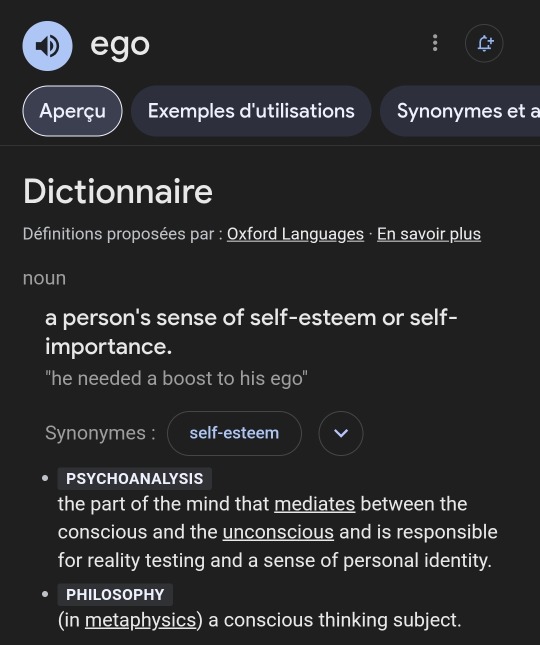
The definition of ego
3) Physical and brain state: encourage entry into the alpha or theta state
Shifting seems to happen more naturally when the brain enters a pre-sleep state (alpha/theta waves). This is also what hypnotists and lucid dreamers seek.
How to encourage this?
- Get into a position where you could fall asleep, but don’t try to sleep
- Gentle, conscious breathing: inhale slowly, exhale even slower
- Let your body become heavy, soft, numb
- Try not to move even if you feel itchy (not mandatory)
Complementary techniques:
- Slow countdown (from 100 to 0, or even from 0 to 0)
- Slow mantras, whispered or gently thought
(“I let myself go,” “I have nothing left to do,”
“My body falls asleep, but my mind travels”)
- Listening to theta/alpha waves
- Gentle immersion in one sense


My favorite alpha/theta wave to listen
4) Calming hypervigilance: the overlooked key
This is probably the main cause of failure for those who "haven’t shifted in a long time".
Hypervigilance = brain constantly on alert:
- "Am I doing it right?"
- "What if I still can’t do it?"
- "I MUST succeed"
- "Is it normal to think like this?"
- "Am I in my DR or not?"
- "How will I know when I’ve arrived?"
Solution:
-> Reconnect with non-goal. Let go of the idea that you must succeed. Tell yourself:
“Tonight, I’m simply going to live the experience.
Even without results, it’s a victory.”
At the moment you shift, focus on internal sensations, breathing, or one of your senses in a soft way without forcing, for example touch or anything else.
Tip: Create a mini-ritual. A soft light, slow ASMR, a relaxation gesture. This conditioning will signal your brain: “You can let your guard down now.”

Even with a strong critical mind it is possible to shift.
5) Encouraging the release of critical thinking during the shifting time
The critical mind is the inner judge, the one that "watches to see if you’ve arrived". It blocks the shift, or at least makes it harder, because it keeps identifying with the ego and prevents letting go.
To deactivate it:
- Don’t use methods that are too rigid (unless they calm your critical mind if you're familiar with them)
- Choose a gentle method, leaving room for imagination without forcing
- Vague visualization or sensations > precise mental images
- Whispered or softly thought affirmations, not shouted or repeated frantically
Example:
“I let myself fall there”, “I’ve already left”, “My mind floats, that’s all”
No matter the affirmation, what matters is that it resonates with you, aligned with your state and emotions.



The methods of those who shift on command
6) Accepting differences in cognitive and sensory profiles
You're not “bad” if you can't visualize.
You're not “broken” if you don’t get it quickly.
Some people:
-Need total silence, others need background sound
-Don’t visualize, but feel
-Have an active mind: in that case, channel it into soft narration (“I’m sinking,” “I’m floating”)
-Need more repetition or conditioning (especially in cases of ADHD, autism, chronic anxiety)
What matters is the general state: calm, relaxation, acceptance, mental letting go.
Basically: it's not a matter of method, but of inner state.
What you should aim for is a modified state of consciousness, emotional relaxation, a soft loss of control, not mental performance.
-> You don’t shift by “thinking better”, you shift by “thinking less”, or rather, by letting go.
At the end, a tip to try tonight:
Lie down, close your eyes.
Breathe slowly. Let your body fall asleep.
Then think gently:
-> ��It’s already done.”
“I have nothing to do.”
“I let myself drift.”
No goal. No visualization. No checking.
If nothing happens? It’s OK. You’ve already started aligning with the needed state.
#fulfillment#shifting#reality shifting#reality shifting community#self concept#shifting methods#shiftinconsciousness#shifting help#desired reality#dr self#shifting reality#kpop shifting#anti shifters dni#black shifters#reality shifter#marvel shifting#shiftblr#shifters#shifting advice#shifting antis dni#shifting blog#shifting community#shifting consciousness#shifting memes#shifting motivation#shifttok#shifting stories#shifting realities#shifting success#shiftingrealities
112 notes
·
View notes
Note
Hello! I was wondering how common or uncommon was the name Sage in the Regency, Victorian, and Edwardian eras?
Sage is my given name and I love those three periods of time and so I am very curious about this, but figured you would know more or at least be able to point me in the right direction of where to find this information since you’re a researcher.
My go-to resource for seeing name popularity over time is behindthename.com.
The United States has tracked name popularity since 1880, and behindthename has a great tool in every entry where they visualize that data. (They also have info available for quite a few other countries, though many of them only have data going back a decade or so).
Here is the visualization for Sage's popularity in the US.
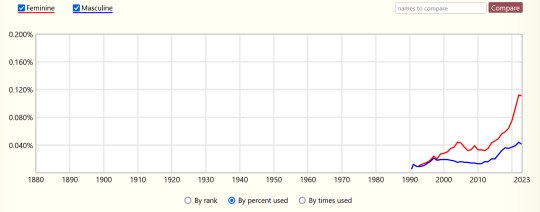
As you can see, Sage is a VERY modern name.
It did not appear in the top 1000 names in the US until 1991 (as a masculine name) and 1993 (as a feminine name).
The highest it has ever ranked was #143 (as a feminine name) - or .11 percent of all given names - in 2022 and 2023 (the 2024 stats haven't been released yet). So 1 out of every 1100 AFAB babies born in the US in 2022/2023 was named Sage.
(In the invented terminology of my Regency name survey that would place it in 'D tier' for 2022/2023.)
Prior to 1880 the name appears extremely rarely. Sage is also a surname, and most cases I can find of it being used as a first name pre-1880 appear to be instances of a family surname converted to a personal name, e.g. John Smith married Jane Sage and named their son Sage Smith.
Most sudden increases in name popularity have what I refer to as a "patient zero" - a celebrity or fictional character with the name that causes it to spike in popularity. I was curious if there was a similar cause for the small, but noticeable spike in Sages that last few years, So I literally just googled "sage character". It's obviously impossible to prove causation without personally interviewing parents to see where they were exposed to/why they chose the name - but the increases in babies named Sage does coincide with the release of the video game Valorant which has a character named Sage, in 2020.
And no, I am not being facetious here - this is actually how name popularity works. Many, many common names owe their popularity - or even their existence - to fictional characters or celebrities. Just ask the 4000+ Khaleesis born in the last decade. I would not be named Samantha without Bewitched. Virtually all Beths owe their name to Little Women (chiefly the 1949 movie adaptation), Madisons to the 1984 Tom Hanks movie Splash, and all the Jessicas/Olivias/Mirandas/Imogens and many more out there can thank Shakespeare.
I'll be interested to see where Sage ranks in the 2024 stats.
Hope that was helpful!
119 notes
·
View notes
Text
10 random facts about Spain you might wanna know for your fan work
My Hetalia hyperfixation came back this 2025 and it's stronger than ever. So to celebrate, I decided to make this post to share with you a little bit of real contemporary Spanish culture and to debunk some stereotypes. If you're writing or creating art about Spain this might help you add some details that will make the character, as well as his relationships with other nations, feel more authentic.

#1. We have two surnames, not a compound one (so it's "Fernández Carriedo", not "Fernandez-Carriedo"). I explained how that works in a post some years ago.
#2. We don't really drink sangría when we go to bars. It's considered a thing for tourists, especially considering how much they can charge you for it. Instead of that, we drink tinto de verano which is a mixture of red wine and either sparkling water or sparkling lemonade (usually the second one). When we do drink sangría, it's usually at a house or student delegation party and the methods we use to prepare it are usually not... very clean or sophisticated. It’s usually just cheap wine mixed with soda, with some chopped fruits thrown in, and it’s often made in a large plastic tub or basin without much concern for presentation or hygiene.
#3. Likewise, the dish that we like the most isn't paella, but tortilla de patatas. You'll find a plate of tortilla in every household when it's time to watch a football match, celebrate a birthday or watch the Eurovision grand final. Also, the only thing this tortilla has in common with the Mexican one is the name.
#4. The olive oil stereotype is way more accurate than the tomato one. We put olive oil in everything. Though if you wanna combine both stereotypes, most Spaniards love to have a toast with tomato pulp, olive oil and salt, either as breakfast or as a snack. The name and preparation of this toast can have slight variatons from region to region.
#5. Most Spaniards don't like bullfighting and even advocate for it to be banned. According to this survey, only 24% of Spaniards like bullfighting and it's usually those amongst the older generations. We usually consider the bullfighter stereotype to be offensive but we also think the imaginery slays (no pun intended) with fashion designers such as Palomo Spain using it in their works (this is the costume he designed for our entry in Eurovision 2022). It's kind of contradicting so take this information as you will. But basically: killing bulls, NO; pretty and shiny costumes, YES.

#6. According to a survey, Portugal (#1) and Italy (#2) are the two countries most liked by Spaniards. According to another survey, those two countries along with Greece would be the ones we'd be the most willing to help in case of a crisis. Can't tell if it's reciprocated, but according to every Spanish student's Erasmus experience ever I would say yes! (If you're not European and don't know what Erasmus is, look it up. Might be useful for a college AU). Also, there seems to be a rise in the idea of Mediterranean/southern European/PIGS pride among youths of any political inclination, often making memes like this one, which may or may not be related to the data I just provided. I'd say we consider the Portuguese to be our siblings, Italians to be our cousins and Greeks to be our distant cousins.
#7. The "th" sound in the neutral European Spanish dialect (the one you hear in movies and shows) isn't a lisp, but a phenomenon linguists call diferenciación. If anyone wants me to explain this in detail, I'll gladly make a separate post about it. If you don't know how it works I suggest you don't use it in fics and stuff because we will point and laugh at you. Especially considering some provinces in Spain only pronounce the S sound, just like Latin Americans.
#8. Though Enrique Iglesias is great, he's not the most popular singer in Spain at the moment, especially since he's retired from music. Spanish girls and gays usually listen to Rosalía, Ana Mena, Lola Índigo or Belén Aguilera, amongst others. Straight people usually listen to Quevedo (ew). David Bisbal was very big in the 2000s and he's still universally loved by all, whether we actually like his music or see him as a living meme. Collaborations with Latin American artists (examples 1, 2, 3) are also very popular and collaborations with Italian artists are becoming increasingly popular (examples 1, 2, 3). I have a playlist of Spanish pop artists (mostly women) that you can check here. If your fic or artwork is set on the 20th Century, you might wanna check this playlist instead. And here's another one for Spanish classical composers.
#9. Doraemon and Crayon Shin Chan are a cultural staple amongst Spaniards raised in the late 90s-2000s-early 2010s. So much so, that there's even an episode of Crayon Shin Chan in which the Nohara family goes to Spain on vacation. I've bonded with Japanese people over this lol
#10. We typically don't use the word "gringo" to refer to USAmericans (though it's becoming more popular now since younger generations are more used to hearing Latin American slang because of both the Internet and recent migrations), we use "guiri" instead. This word is used to describe people who are whiter than us, for lack of a better explanation. So, basically, Central Europeans + Nordics + Brits + USAmericans + Canadians. Like most words in Spanish, it can be considered either a neutral descriptor or a pejorative term depending on the context and intonation. For example, if a Spaniard has an English or German partner, they may call them "mi guiri" (my guiri) as a light-hearted tease. However, if we're talking about drunk English tourists jumping from balconies... then yes, it's definitely pejorative.
I'd love it if anyone else in the fandom does this with facts about their country because I love learning new things about other cultures and peoples. So if you write a post like this, please tag me so I can read it! Also if you want me to confirm or debunk any stereotype let me know and I'll do it in the comments.
Bonus fun fact: Spain is the gayest country in Europe (based on the percentage of people that identify as LGBT+).
#wrote this while commuting yayyyyy#kind of inspired by a conversation i had with international friends yesterday#hetalia#hws#hws spain#aph spain#antonio fernandez carriedo#hetalia fanart#aph#hws hetalia
145 notes
·
View notes
Text

Anubismon EX5-062 Alternative Art by sasasi from EX-05 Theme Booster Animal Colosseum
This Alternative Art is a reference to the Reference Book entry of Anubismon, according to which it is the Judge to decide wether or not a Digimon gets reborn as a Digitama.
A God Man Digimon that guards and supervises the Dark Area. It constantly surveys the Dark Area, to which Digimon that were deleted when their life span finished, or when they were defeated in battle, are ultimately transmitted (and are transmitted there despite Fallen Angel Digimon and their like inhabiting it). As for the Digimon transferred to the Dark Area, if their data is evil, it imprisons them within eternal darkness, but if their data is good, it has the ability to reset them back to a Digitama. It has power as mighty as to decide the rebirth of a Digimon, and furthermore, it has the role of the Digital World's judge. Its Signature Move is drawing a square pyramid with beams of light as depicted in Egypt's secret formulas, then imprisoning the opponent within it (Pyramid Power). Its Special Move "Ammit" is a terrifying technique that summons a demonic beast from hell, which devours the Digicores of evil Digimon.
#digimon#digimon tcg#digimon card game#digisafe#digica#デジカ#digimon references#Anubimon#Anubismon#AA#EX5#digimon card#color: purple#Lv6#type: vaccine#trait: Shaman#trait: God Man#num: 03#sasasi
305 notes
·
View notes
Text
Reference saved in our archive
Why we still need to mask:
For SARS-CoV-2, the correlation was highly significant between clinical and hospitalization data (ρ = 0.8460), but not significant between wastewater and clinical or hospitalization data (ρ = 0.1682 and ρ = 0.0569, respectively). SARS-CoV-2 RNA was found in wastewater even in period when clinical cases were not reported, indicating a continuous community circulation.
Wastewater decoupling from clinical data shows potential for an international lack of testing.
Highlights •SARS-CoV-2 RNA in wastewater showed circulation even in absence of clinical reports. •Human Adenovirus respiratory species showed a seasonal distribution. •Respiratory Syncytial Virus was locally detected in wastewater during national epidemic season. •Influenza virus was never detected, even during the period of highest circulation. •Detection strategies and methods must be specifically targeted to the surveyed pathogens.
Abstract During the COVID-19 pandemic, wastewater-based surveillance (WBS) showed great potential as an early warning system and could complement human clinical surveillance. This study aimed to highlight the added value of WBS for respiratory infections alongside different clinical surveillance systems. Sewage collected at the entry of four Wastewater Treatment Plants in Northern Tuscany (Italy) were analyzed for SARS-CoV-2, Human Adenovirus (HAdV), Respiratory Syncytial Virus (RSV) and Influenza Virus (IV), over two years. Clinical data for COVID-19 were available for the study area, while data for other viruses came from national virological surveillance. For SARS-CoV-2, the correlation was highly significant between clinical and hospitalization data (ρ = 0.8460), but not significant between wastewater and clinical or hospitalization data (ρ = 0.1682 and ρ = 0.0569, respectively). SARS-CoV-2 RNA was found in wastewater even in period when clinical cases were not reported, indicating a continuous community circulation. HAdVs were detected in 74.3 % of samples, but most of the sequences identified belonged to enteric species (HAdV-F41), indicating the need of distinguishing the species causing respiratory diseases for the surveillance. RSV were found only in winter 2022–2023, while IV had not been detected in wastewater, probably due to poor test sensitivity. In conclusion, although there may be various challenges in testing different targets, WBS can provide pathogen-specific situational assessment which complements existing surveillance systems.

#mask up#public health#wear a mask#pandemic#wear a respirator#covid#covid 19#still coviding#coronavirus#sars cov 2#wastewater tracing#covid wastewater
48 notes
·
View notes
Text
SURVEY BREAKDOWN
(long post warning)
**A FEW DISCLAIMERS**
I AM NOT A SCIENTIST, I AM A HUMANITIES BITCH. My math skills are limited, and I have no training on processing/presenting this sort of data. I am also one person with a shitty laptop, an unreliable internet connection, and a very busy personal life. Take all of this with an extremely large grain of salt.
Participants are self-reporting. They may not know for sure, they may be wrong, they may be lying. I took everyone here at their word. I tried not to extrapolate much from what they were saying, because I do not want to misrepresent what they said.
I will be covering why people thought they developed this fetish in a later post because this is already too long.
Gender of Participants

*According to a 2024 survey, 1.14% of American adults identify as transgender, while 1.52% do not identify as male, female, or trans (some of whom identified as Non-Binary.) That makes the presence of trans and non-binary participants VASTLY disproportional to the American average. I'm sure some of it can be explained by younger people being more likely to identify as not cis, and younger people using the internet far more than the older generations. I also read a paper once that suggested the internet was responsible for the development of more niche fetishes. It's also possible that trans people are more likely to be comfortable engaging with communities surrounding 'deviant' sexual interests because they've already been labeled 'abnormal' (BUT THESE ARE ALL JUST GUESSES). What I theorize is that, because pregnancy is inextricable from sex organs and gender rolls, trans people (ESPECIALLY AFAB trans/non-binary people) are more likely to have those early, strong emotional reactions to pregnancy that seem to develop into fetishes. I'll get into this more on my next post.
*cis women outnumbering cis men was not something I was expecting, but makes sense, since young girls often have to think about pregnancy much sooner than boys, and it threatens to have a much greater impact on their life.
*in retrospect, I wish I'd included a question on how the participants found the survey, since knowing might help explain the disparity between trans and cis people.
Sexuality of Participants
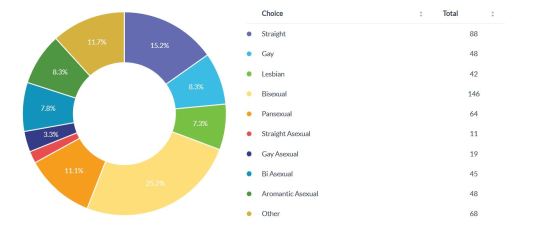
*most (but not all) of the people who chose "other" wrote in an ace-spec identity not included in the above choices (ace lesbian, demi-sexual, etc.,)
Content of Fetish Material Consumed
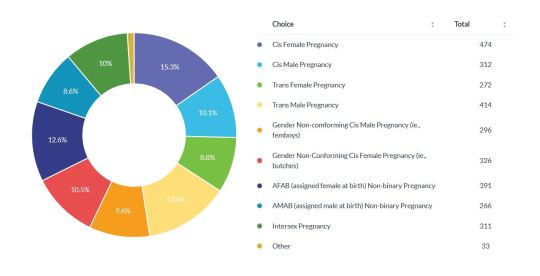
*the vast majority of participants selected multiple answers, the exception to this was straight cis men, who often only selected the 'Cis Female Pregnancy' option (a small percentage of this group also answered femboys). The minority of straight cis men who chose other options most often fantasized about becoming pregnant themselves.
When the Fetish was Developed

*One person wrote in that they didn't believe children could have fetishes. Their entry was shortly followed by one from someone who described frequently masturbating to fantasies surrounding pregnancy at the age of 5. This isn't important to the overall data, I just find it funny.
How Great a Role does the Participants' Fetish Play in their Achieving Arousal?
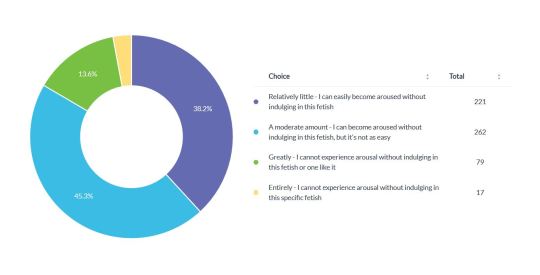
How Great a Role does Sex Play in the Participants' Fetish Related Fantasies?

Did the Participants' Pregnancy Fetish Play a Role in their First Time Experiencing Arousal?
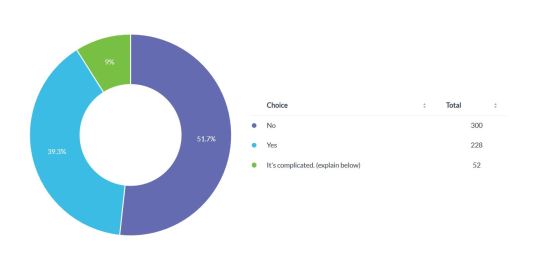
*most of the "it's complicated" answers were people who couldn't remember their first time experiencing arousal.
...
That's the basics down, stay tuned for a breakdown of why people think they developed their fetish.
(will be linked when post is done).
95 notes
·
View notes
Text
Happy National Zookeeper Week!
I’ll admit, I’m feeling a little spicy about it this year (well, every year) because zoos use the celebration for lots of positive facility PR, yet staff don’t often get the support and respect that is claimed in those posts.
So I want to share this great article written by a zoo industry consulting group last year looking at the reality of what happens when a workforce ends up conflicted between their passion (zoos and animals) and pragmatism (paying rent, existing in a capitalist society). They assessed AZA compensation rates by region against things such as a living wage and rental rates in the area. (All text formatting within quotes, such as bold and italics, is original to the article text.)
I cannot give the Canopy Group enough support for the way they framed this research:
“By observing the economics of keeper compensation, it’s no secret that keepers land on the lower end of the wage spectrum. Like all other wages and salaries, the market value of keeper compensation is driven by several economic factors – including the size of the labor pool, the rigor and danger of the work, the technical ability required, and the educational requirements. However, there is one factor that artificially lowers the market value of keeper compensation more than any other: passion.
In this article, we’ll take a look at why passion lowers the market value of animal care worker wages. More importantly, we’ll consider many factors that have emerged in recent years that are making people reevaluate the value of following their passion – a trend contributing to The Great Resignation, especially as it applies to zoos, aquariums, and similar organizations. (…)
The argument here is passion versus pragmatism: the unknown versus the sure thing. It is a decision all zookeepers and animal care technicians have made. Working with animals is immensely rewarding, but this passion is also very popular. This, historically, has meant that the keeper candidate pool is very large. Therefore, if the wage is livable and working conditions are reasonable, the pool should remain large. In a very real sense, a passion for animals drives down the market value of keeper compensation. Anyone who has been through an Economics 101 course will recognize this as a fundamental market principle: supply vs. demand.
However, many zoos and aquariums are having a more difficult time filling positions than normal and have started to see higher turnover rates in recent years. This begs the question – is the current keeper wage too low?”
Their findings?
Here’s their graph of “the median wage of keepers from organizations in different AZA-defined regions” from an AZA survey done in 2021. (Median is the type of average that looks at the middle of a data set’s range).
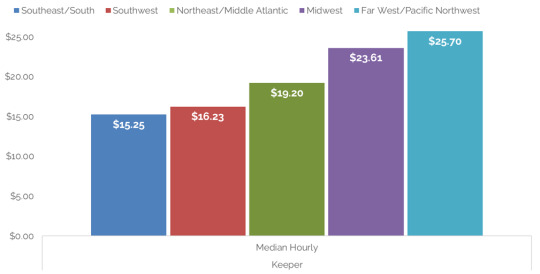
The median wage for AZA keepers in the South/Southeast was just over $15/hr at the low end, and the median wage for AZA keepers in the Far West / PNW was a little under $26/hr. That’s pretty dang low everywhere, especially when you factor in the increased cost of living in places like the West Coast. Also consider that looking at the median wage doesn’t mean this reflects just entry-level compensation - this data indicates the the compensation middle for all keeper positions, including people who have built their careers as keepers in those places long-term.
Then, they compared those wages to the “living wage” in each region - which they defined as “a calculation of what it takes to live in a particular area, without any other income. A living wage calculation takes into consideration how many earners are in a household, how many children are being supported, etc. The living wage includes the costs of all the basic items a household needs to be self-sufficient.”
“If you receive a wage for a job that is below the living wage, then you are essentially taking a negative net income. This is unsustainable for the long term, and essentially defines where wages start to exploit passion.”
Here’s a figure they provided using the MIT Living Wage Calculator showing the average living wage for each of the AZA regions. The chart on the left shows the living wage for a single person with no kids; the second, for two parents with two incomes and one child to support.
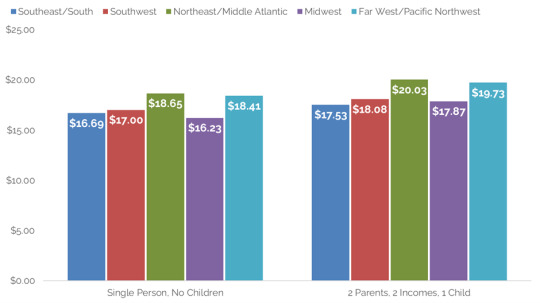
“By comparing the two graphs [to the earlier graph of the AZA median compensation rates], we find that median wages in the Southeast/South and Southwest regions are lower than the living wage for each household configuration in those regions. In other words, if you are a single person household or part of a two-income household raising 1 child in the South, a starting keeper salary will likely leave you with a negative net income. While many people work at this level, it increases the risk of accumulating debt, lowers a person’s ability to afford a home, set a much later retirement age, and can lead to many other negative, long-term effects.”
Big yikes, right?
Next, they looked at living wage vs. compensation for single parents.
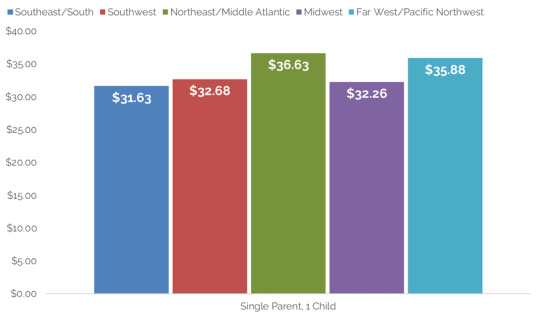
“The single-parent living wage exceeds the average keeper wage in all AZA regions. In fact, the living wage required as a single parent is double the average AZA keeper wage in some regions.”
And then they did housing, specifically, being able to purchase a home.
“In many places, even a two-income household at an average keeper salary would not purchase a mid-level home. This means that keepers have to wait far longer than their peers to purchase a home. While paying rent in the meantime, this rent will account for a larger portion of their income than their peers. All in, these effects can set hopeful homeowners back years or decades.”
Canopy’s conclusion was something anyone involved in the field knew was coming.
“Companies like Chipotle, McDonalds, Best Buy, FedEx, Home Depot, Publix, and Walmart are all offering similar starting wages near starting keeper wages – plus many fringe benefits (like tuition reimbursement) and ample advancement opportunities. Many potential keepers in younger generations are putting their passion on the shelf so they can meet basic standard-of-living concerns.
To attract and retain quality candidates, an organization must consider the journey each new employee would have to make over their career. If the journey is fraught with massive debt, decreased disposable income, and limited career opportunities, then you are limiting your potential candidate pool to the small group of people who have decided that following their passion is worth significant lifelong financial hardship. There are many potential candidates out there willing to sacrifice and arm and leg for animals and conservation, but they wouldn’t dare jeopardize the financial future of their dependents and families.”
This is something I’ve heard about for years, and seen first hand. The low average wage at zoological facilities has been damaging their ability to hire and retain skilled staff for as long as I’ve been involved in the industry. I know so many zookeepers who still have roommates into their 30’s, or work multiple jobs, just to be able to make ends meet.
There’s a mythology about zookeeping jobs, a narrative that seeps into the field and actively exploits people’s passion for the job: it tells people that they’re so lucky to be able to work with these rare and cool animals; that they’re greedy and ungrateful when they ask for more compensation because they’re privileged to get to have the job at all. It says that most people would give anything to have these opportunities, so current zookeepers are interchangable and easily replaceable. Ask for too much? Push for a living wage? There’s always someone willing to take your spot. Not all facilities perpetuate this mentality - some places do treat their staff well without intentionally manipulating them to stay them in unsustainable jobs, and there can be legitimate financial reasons that limit staff compensation (mostly at smaller facilities, afaik) - but it’s a reality in the field.
For a long time, this type of mentality towards staff was sustainable. There really were always more people wanting to work in the field. But now, after three years of pandemic stressors and inflation, it’s starting to be a problem. A lot of staff left during the last few years, and facilities are having a really hard time hiring people and retaining them for any duration. I think a large part of that is low compensation rates. People are prioritizing long-term financial stability and recognizing when their passion is being exploited.
When I first started on tumblr back in 2011, there was a whole group of us within the United States who were baby zookeepers or volunteering as industry hopefuls. We all became friends, and I’ve stayed in touch with, or at least aware of, most of them as their careers progressed. Of the 10-15 or so people in that cohort? I can think of three who are still employed in the zoo industry. Everyone else has moved on into other fields - often with great grief over the loss - because of the extreme emotional labor, the physical exhaustion, and the lack of appropriate compensation.
But I guess that annual pizza party, being featured on social media, and maybe getting additional snacks all week makes up for it all?
#national zookeeper week#zoo industry#living wage#compensation#please support your local zookeeper#AZA accreditation#AZA zoos#zoos
557 notes
·
View notes
Text
came up with a really nuts theory with the help of sleep deprivation

right so before this begins there will be both spoilers for undertale AND deltarune. and also don’t expect this to be coherent, this is all off the dome.
surface level obervations first, they’re both human beings that look similar and are around the same age as the main protagonist.
chara -like the vessel- has a placeholder name. in the japanese translation they’re called キャラ (kyara) confirming that their name is short for “character”.
chara in undertale played the role of being the representation of the player’s progress and choices. (HP. ATK. DEF. GOLD. EXP. LV. every time a number increases, that feeling... that’s me.) and deltarune opens with you being tasked with creating a vessel to represent yourself. your creation contains your favorite taste, blood type, favorite color, etc. and while gaster claims that the vessel’s been discarded, its data is still saved in the game’s save file. so like chara, the vessel is a representation of the player’s data.
on that note, you can argue that the survey at the beginning mirrors the genocide ending of undertale. the one ending where you meet chara face to face. both have a human in the center of a blank void while an ominous voice talks to you directly. and both abruptly end with your choice being taken away from you in favor of starting the game again in the way the voice wants. (chara deleting the world and gaster moving you into kris’s body instead)
to build off of the abrupt loss of control. in undertale chara is among the few characters to take control away from the player and succeed. in the neutral route asgore takes away your ability to spare him but you refuse to kill him anyways, flowey overwrites your saves so he can kill you over and over again but the souls intervene. chara directly tells you that you aren’t the one in control and deletes your save data after you tell them not to. and obviously, loss of control is one of the central themes of deltarune.
so the connection between chara and the vessel is more or less well established at this point - at least to me - so what about the knight? how does that fit into all of this?
at the end of chapter 2, we lose control of kris once again. and they open a dark fountain in their living room. as of right now, we don’t really know the reason for doing this. after all, if the goal is to banish the angel’s heaven, why would they open another fountain? kris has been shown to have good memories of home town, so why would they want to send it into eternal darkness? unless we still do have control of kris. but instead of us, it’s our vessel taking control.
throughout the game kris gets told time and time again that their choices don’t matter. so wouldn’t it make sense for the knight to be a representation of the player’s choices? to have it so that kris will have to free themself from the decisions of their oppressor in order to banish the angel’s heaven?
of course, the vessel is a goner as well. its thoughts and data are our own but it is still gaster’s creation. and entry seventeen in undertale has gaster describe an experiment involving a growing darkness as ‘very very interesting’ so it would make sense for gaster to let the vessel open dark fountains.
oh and it’s implied that at the end of the game asriel will come home, and since asriel and chara were siblings in deltarune it would make sense for them to appear at around the same time.
in conclusion: gaster created the knight who is the vessel and the vessel is meant to be an alternate version and narrative parallel to chara from undertale. thank you for reading this gobbledygook.
14 notes
·
View notes
Note
Name reading question - you'll say sometimes "usually read as" or "rarely read as" and such. Is that something you just pick up over time having seen this name said this way many times, or is there some sort of website/reference guide for percentages of readings (such as "this name is read this way 90% of the time")?
(Thank you for doing this blog, really helps with my kanji learning!)
I'm so glad this blog is helpful! It's nice that my weird fixations can somehow be useful :D
There's some instinct, but I don't rely on it. The sites I use most often are Myōji Yurai and NameGen. To give you an idea of how it works, let's search 渡部 on Myōji Yurai.

It gives you a list of possible readings, plus how common the name is and how many people it belongs to. It also sometimes has interesting information on the genesis or history of the name, or how it's distributed throughout the country, which I like.
Looking at the list, I'm always kinda like, "Well, I feel like I've met a Watanabe (of varying kanji) maybe... every three days for the last 15 years. And I know precisely one named Watabe (and she has to clarify constantly), and none of the other variations are familiar at all." And then I check that against NameGen.

Hard to read, but oh well. Looks like Watanabe makes up 73.9%, Watabe 25.6% (more than I thought), and the remaining half percent is shared byyyyyy..... two other names.
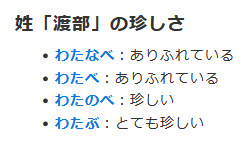
Okay. Watanabe and Watabe are both Commonplace, and the two tiny ones are Watanobe, which it ranks as Rare, and Watabu, which is Very Rare. Watahe, which Myōji Yurai suggested, doesn't register at all here, but the disclaimer at the bottom of the first image says that there may also exist other readings because they don't have a comprehensive survey.
(Also, I chose this name at random but it turned out to be an interesting example because it shows that the demarcation point between Rare and Very Rare is somewhere between *squints* 0.4% and 0.2%. I think. [They round off, so the total is 100.1% here.])
So if it's not comprehensive, how reliable is it? One of the things I like about this site is that they rank the reliability of each individual entry based on sample size.


They rate this data as A: Quite Reliable, which is the second highest on a 6-point scale. Typically, the rarer the name is, the less reliable the stats are. Which is unfortunate because the rarer names are the ones I'm most likely to notice and research! Oh well.
In conclusion, I'm not sure if these are the most reliable resources out there, but they're what I got used to using in my day job. Anyone who knows of any other good (free) resources, please do share!
34 notes
·
View notes